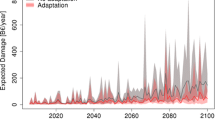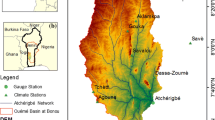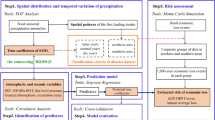Abstract
Due to the rapidly changing climate, the frequency of extreme rainfall has increased worldwide. Consequently, various climate change adaptation policies have been proposed to mitigate the increasing flood risk. However, few studies have examined the effects of these adaptation policies on flood damage. Therefore, this study developed a research framework to evaluate the flood damage reduction effect of adaptation policies to the changing climate. A flood damage function developed for 15 administrative districts in South Korea was integrated with an adaptation policy effect assessment module based on a non-linear regression model and a climate change impact assessment module based on non-stationary frequency analysis. Historic climate data and future climate projection data from CMIP6 global climate models were used for the frequency analysis. The flood damage reduction effect of climate change adaptation policies was determined across various future projection periods and temperature increase scenarios. It was found that the flood damage gradually increased from the +2 °C scenario to the +5 °C scenario, though this flood damage was reduced by 43–44% with the implementation of corresponding adaptation policies. The macro-scale assessment framework proposed in this research, which incorporates flood damage records, climate observations, socioeconomic data reflecting flood mitigation capabilities, and climate model outputs for future projections, has the potential to be employed for a wide range of applications.







Similar content being viewed by others
Data availability
The data sets generated during the current study are available from the corresponding author on reasonable request.
References
Abd-Elaty I, Kuriqi A, Pugliese L, Zelenakova M, El Shinawi A (2023) Mitigation of urban waterlogging from flash floods hazards in vulnerable watersheds. J Hydrol: Reg Stud 47:101429
Bhattarai R, Yoshimura K, Seto S, Nakamura S, Oki T (2016) Statistical model for economic damage from pluvial floods in Japan using rainfall data and socioeconomic parameters. Nat Hazards Earth Syst Sci 16(5):1063–1077
Babovic F, Mijic A (2019) The development of adaptation pathways for the long-term planning of urban drainage systems. J Flood Risk Manage 12(S2):e12538
Centre for Research on the Epidemiology of Disasters (CRED) (2022) 2021 Disaster in numbers. Brussels: CRED. https://cred.be/sites/default/files/2021_EMDAT_report.pdf
Cowtan K, Way RG (2014) Coverage bias in the HadCRUT4 temperature series and its impact on recent temperature trends. Q J Roy Meteorol Soc 140(683):1935–1944
Déqué M, Calmanti S, Christensen OB, Aquila AD, Maule CF, Haensler A et al (2017) A multi-model climate response over tropical Africa at + 2 C. Climate Services 7:87–95
Dix M, Bi D, Dobrohotoff P, Fiedler R, Harman I, Law R, Yang R (2019) CSIRO-ARCCSS ACCESS-CM2 model output prepared for CMIP6 CMIP historical. Earth Syst Grid Fed. https://doi.org/10.22033/ESGF/CMIP6.4271
Escuder-Bueno I, Castillo-Rodríguez JT, Zechner S, Jöbstl C, Perales-Momparler SARA, Petaccia G (2012) A quantitative flood risk analysis methodology for urban areas with integration of social research data. Nat Hazards Earth Syst Sci 12(9):2843–2863
Feyen L, Ciscar Martinez JC, Gosling S, Ibarreta Ruiz D, Soria Ramirez A, Dosio A, Naumann G, Russo S, Formetta G, Forzieri G, Girardello M (2020) Climate change impacts and adaptation in Europe. JRC PESETA IV final report (No. JRC119178) Joint Research Centre (Seville site)
Gu X, Ye L, Xin Q, Zhang C, Zeng F, Nerantzaki SD, Papalexiou SM (2022) Extreme precipitation in China: a review on statistical methods and applications. Adv Water Resour 163:104144
Hammond MJ, Chen AS, Djordjević S, Butler D, Mark O (2015) Urban flood impact assessment: a state-of-the-art review. Urban Water J 12(1):14–29
Huang P, Zheng XT, Ying J (2019) Disentangling the changes in the Indian Ocean dipole–related SST and rainfall variability under global warming in CMIP5 models. J Climate 32(13):3803–3818
Islam MN, van Amstel A, Islam MN, Tamanna S, van Amstel A, Noman M et al (2021) Climate change impact and comprehensive disaster management approach in Bangladesh: a review. In: climate change impacts, Mitigation and adaptation in developing countries, Bangladesh II, pp 1–39
Jee HW, Seo SB, Ko K, Cho J, Chae Y (2023) Macro-scale impact assessment of flood damage reduction from climate change adaptation policies. J Flood Risk Manage e12969. https://doi.org/10.1111/jfr3.12969
John JG, Blanton C, McHugh C, Radhakrishnan A, Rand K, Vahlenkamp H et al (2018) NOAA-GFDL GFDL-ESM4 model output prepared for cmip6 scenarioMIP. Earth Syst Grid Fed. https://doi.org/10.22033/ESGF/CMIP6.1414
Kim YO, Seo SB, Kim GJ (2020) Incorporation of robustness and adaptiveness into reservoir operations under climate change. In: Climate Change-Sensitive Water Resources Management. CRC Press, pp 140–160
Klipalo E, Besharat M, Kuriqi A (2022) Full-scale interface friction testing of geotextile-based flood defence structures. Buildings 12(7):990
Laloy E, Vrugt JA (2012) High-dimensional posterior exploration of hydrologic models using multiple-try DREAM (ZS) and high-performance computing. Water Resour Res 48(1):W01526
Masson-Delmotte V, Zhai P, Pirani A, Connors SL, Péan C, Berger S, Caud N, Chen Y, Goldfarb L, Gomis MI, Huang M, Leitzell K, Lonnoy E, Matthews JBR, Maycock TK, Waterfield T, Yelekçi O, Yu R, Zhou B (2021) Climate change 2021: The physical science basis. Contribution of working group I to the sixth assessment report of the Intergovernmental Panel on Climate Change
Morice CP, Kennedy JJ, Rayner NA, Winn JP, Hogan E, Killick RE, Dunn RJ, Osborn TJ, Jones PD, Simpson IR (2021) An updated assessment of near-surface temperature change from 1850: the HadCRUT5 data set. J Geophys Res Atmos 126(3):e2019JD032361
Nand MM, Bardsley DK, Suh J (2023) Addressing unavoidable climate change loss and damage: a case study from Fiji’s sugar industry. Clim Change 176(3):21
Le TDN (2020) Climate change adaptation in coastal cities of developing countries: characterizing types of vulnerability and adaptation options. Mitig Adapt Strat Glob Chang 25(5):739–761
Lenssen NJ et al (2019) Improvements in the GISTEMP uncertainty model. J Geophys Res Atmos 124(12):6307–6326
Li C, Zwiers F, Zhang X, Li G, Sun Y, Wehner M (2021) Changes in annual extremes of daily temperature and precipitation in CMIP6 models. J Climate 34(9):3441–3460
Luke A, Vrugt JA, AghaKouchak A, Matthew R, Sanders BF (2017) Predicting nonstationary flood frequencies: evidence supports an updated stationarity thesis in the United States. Water Resour Res 53(7):5469–5494
Pistrika A, Tsakiris G, Nalbantis I (2014) Flood depth-damage functions for built environment. Environ Process 1:553–572
Rohde RA, Hausfather Z (2020) The Berkeley Earth land/ocean temperature record. Earth Syst Sci Data 12(4):3469–3479
Ryu Y, Kim YO, Seo SB, Seo IW (2018) Application of real option analysis for planning under climate change uncertainty: a case study for evaluation of flood mitigation plans in Korea. Mitig Adapt Strat Glob Chang 23:803–819
Seo SB, Kim YO, Kim Y, Eum HI (2019) Selecting climate change scenarios for regional hydrologic impact studies based on climate extremes indices. Climate Dynam 52:1595–1611
Shin Y, Shin Y, Hong J, Kim MK, Byun YH, Boo KO et al (2021) Future projections and uncertainty assessment of precipitation extremes in the Korean Peninsula from the CMIP6 ensemble with a statistical framework. Atmosphere 12(1):97
Stedinger JR, Griffis VW (2011) Getting from here to where? Flood frequency analysis and climate 1. JAWRA J American Water Resour Assoc 47(3):506–513
Swart NC, Cole JN, Kharin VV, Lazare M, Scinocca JF, Gillett NP et al (2019) IPCC DDC: CCCma CanESM5 model output prepared for CMIP6 ScenarioMIP. Earth Syst Grid Fed. https://doi.org/10.22033/ESGF/CMIP6.1317
United States Global Change Research Program (2018) Impacts, risks, and adaptation in the United States: fourth national climate assessment, Volume II. In: Reidmiller DR, Avery CW, Easterling DR, Kunkel KE, Lewis KLM, Maycock TK, Stewart BC (eds) U.S. global change research program. Washington, DC, USA, p 1515. https://doi.org/10.7930/NCA4.2018. https://nca2018.globalchange.gov/downloads/NCA4_2018_FullReport.pdf
Vrugt JA, Ter Braak CJF, Diks CGH, Robinson BA, Hyman JM, Higdon D (2009) Accelerating Markov chain Monte Carlo simulation by differential evolution with self-adaptive randomized subspace sampling. Int J Nonlinear Sci Numer Simul 10(3):273–290
Vu TM, Mishra AK (2019) Nonstationary frequency analysis of the recent extreme precipitation events in the United States. J Hydrol 575:999–1010
Zhou Q, Mikkelsen PS, Halsnæs K, Arnbjerg-Nielsen K (2012) Framework for economic pluvial flood risk assessment considering climate change effects and adaptation benefits. J Hydrol 414:539–549
Zhu W, Zha X, Luo P, Wang S, Cao Z, Lyu J et al (2023) A quantitative analysis of research trends in flood hazard assessment. Stochastic Environ Res Risk Assess 37(1):413–428
Funding
This study was carried out with the support of the Research Program for Agricultural Science and Technology Development (Project No. RS-2021-RD009055), the National Institute of Agricultural Sciences, Rural Development Administration, Republic of Korea.
Author information
Authors and Affiliations
Corresponding author
Ethics declarations
Conflict of interest
The authors declare no competing interests.
Additional information
Publisher’s note
Springer Nature remains neutral with regard to jurisdictional claims in published maps and institutional affiliations.
Supplementary information
ESM 1
(DOCX 76 kb)
Rights and permissions
Springer Nature or its licensor (e.g. a society or other partner) holds exclusive rights to this article under a publishing agreement with the author(s) or other rightsholder(s); author self-archiving of the accepted manuscript version of this article is solely governed by the terms of such publishing agreement and applicable law.
About this article
Cite this article
Seo, S.B., Jee, H.W., Cho, J. et al. Assessment of the flood damage reduction effect of climate change adaptation policies under temperature increase scenarios. Mitig Adapt Strateg Glob Change 29, 8 (2024). https://doi.org/10.1007/s11027-024-10105-9
Received:
Accepted:
Published:
DOI: https://doi.org/10.1007/s11027-024-10105-9




